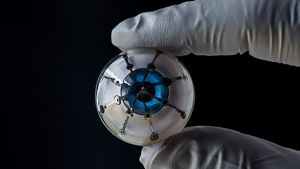
Scientists at the University of Minnesota have 3D printed a device that could serve as the predecessor for the bionic eye. Researchers constructed a hemispherical surface, then 3D printed an assortment of light receptors across the surface. Scientists believe this work lays solid groundwork for successfully creating an eye that could help blind people to see.
“Bionic eyes are usually thought of as science fiction, but now we are closer than ever using a multimaterial 3D printer.”
Scientists used a custom-built 3D printer and a hemispherical glass dome. A base ink of silver particles was affixed to the curved surface; the nature of the ink allowed for it to dry uniformly. Next, semiconducting polymer materials were used to print photodiodes. The photodiodes convert the light into electricity. The entire process, from start to finish, takes about one hour.
Results showed that the fully 3D-printed semiconductors were capable of converting light to electricity at 25% efficiency. This lends credence to the idea that 3D-printed semiconductors could one day rival those fabricated using traditional methods. Additionally, the 3D-printing method works with curved surfaces, which has long proven a challenge for conventional semiconductors.
This isn’t the team’s first foray into the world of 3D-printing. The team behind the eye has a history of integrating electronics, biology, and 3D-printing onto a single working platform. They have previously printed a ‘bionic ear.’ The team has also created an assortment of life-like artificial organs that can be used for surgical practice. They designed an electronic fabric that could lay the groundwork for ‘bionic skin,’ and grafted electronics directly onto a moving hand. Additionally, the team is working on providing devices that could help restore function for those living with spinal cord injuries.
Despite these impressive innovations, there is still a long way to go before these devices are readily available. One of the top priorities for the team is finding a way to routinely and reliably print active electronics. This would provide researchers with the tools they need to continue their work on this subject.
Next up, the team of scientists will attempt to create a prototype with even more light receptors, to increase the efficiency of their design. The team is also researching ways to print on a soft hemispherical material. Once this is accomplished, researchers can work on the logistics of implanting their design into a real human eye.